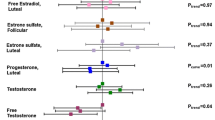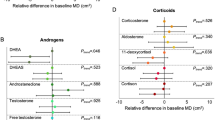Abstract
Higher circulating prolactin levels have been associated with higher percent mammographic density among postmenopausal women in some, but not all studies. However, few studies have examined associations with dense area and non-dense breast area breast or considered associations with prolactin Nb2 lymphoma cell bioassay levels. We conducted a cross-sectional study among 1,124 premenopausal and 890 postmenopausal women who were controls in breast cancer case–control studies nested in the Nurses’ Health Study (NHS) and NHSII. Participants provided blood samples in 1989–1990 (NHS) or 1996–1999 (NHSII) and mammograms were obtained from around the time of blood draw. Multivariable linear models were used to assess the associations between prolactin levels (measured by immunoassay or bioassay) with percent density, dense area, and non-dense area. Among 1,124 premenopausal women, percent density, dense area, and non-dense area were not associated with prolactin immunoassay levels in multivariable models (p trends = 0.10, 0.18, and 0.69, respectively). Among 890 postmenopausal women, those with prolactin immunoassay levels in the highest versus lowest quartile had modestly, though significantly, higher percent density (difference = 3.01 percentage points, 95 % CI 0.22, 5.80) as well as lower non-dense area (p trend = 0.02). Among women with both immunoassay and bioassay levels, there were no consistent differences in the associations with percent density between bioassay and immunoassay levels. Postmenopausal women with prolactin immunoassay levels in the highest quartile had significantly higher percent density as well as lower non-dense area compared to those in the lowest quartile. Future studies should examine the underlying biologic mechanisms, particularly for non-dense area.
Similar content being viewed by others
Abbreviations
- NHS:
-
Nurses’ Health Study
- BMI:
-
Body mass index
- BBD:
-
Benign breast disease
- CV:
-
Coefficient of variation
- ICC:
-
Intraclass correlation coefficient
References
Byrne C et al (1995) Mammographic features and breast cancer risk: effects with time, age, and menopause status. J Natl Cancer Inst 87(21):1622–1629
Boyd NF et al (1995) Quantitative classification of mammographic densities and breast cancer risk: results from the Canadian National Breast Screening Study. J Natl Cancer Inst 87(9):670–675
Tworoger SS, Hankinson SE (2008) Prolactin and breast cancer etiology: an epidemiologic perspective. J Mammary Gland Biol Neoplasia 13(1):41–53
Boyd NF et al (2002) The association of breast mitogens with mammographic densities. Br J Cancer 87(8):876–882
Greendale GA et al (2007) Serum prolactin levels are positively associated with mammographic density in postmenopausal women. Breast Cancer Res Treat 105(3):337–346
Bremnes Y et al (2007) Endogenous sex hormones, prolactin and mammographic density in postmenopausal Norwegian women. Int J Cancer 121(11):2506–2511
Maskarinec G et al (2007) IGF-I and mammographic density in four geographic locations: a pooled analysis. Int J Cancer 121(8):1786–1792
Tamimi RM et al (2005) Endogenous sex hormone levels and mammographic density among postmenopausal women. Cancer Epidemiol Biomark Prev. 14(11 Pt 1):2641–2647
Walker K et al (2009) Premenopausal mammographic density in relation to cyclic variations in endogenous sex hormone levels, prolactin, and insulin-like growth factors. Cancer Res 69(16):6490–6499
McCormack VA et al (2009) Sex steroids, growth factors and mammographic density: a cross-sectional study of UK postmenopausal Caucasian and Afro-Caribbean women. Breast Cancer Res 11(3):R38
Pettersson A et al (2011) Nondense mammographic area and risk of breast cancer. Breast Cancer Res 13(5):R100
Lokate M et al (2011) Mammographic density and breast cancer risk: the role of the fat surrounding the fibroglandular tissue. Breast Cancer Res 13(5):R103. doi:10.1186/bcr3044
Hoffmann T, Penel C, Ronin C (1993) Glycosylation of human prolactin regulates hormone bioactivity and metabolic clearance. J Endocrinol Invest 16(10):807–816
Sinha YN (1995) Structural variants of prolactin: occurrence and physiological significance. Endocr Rev 16(3):354–369
Gout PW, Beer CT, Noble RL (1980) Prolactin-stimulated growth of cell cultures established from malignant Nb rat lymphomas. Cancer Res 40(7):2433–2436
Tworoger, S.S., et al., (2014) Bioactive prolactin levels and risk of breast cancer: a nested case–control study. Cancer Epidemiol Biomark Prev
Schernhammer ES et al (2005) Circulating levels of insulin-like growth factors, their binding proteins, and breast cancer risk. Cancer Epidemiol Biomark Prev 14(3):699–704
Tworoger SS, Sluss P, Hankinson SE (2006) Association between plasma prolactin concentrations and risk of breast cancer among predominately premenopausal women. Cancer Res 66(4):2476–2482
Schernhammer ES, Hankinson SE (2009) Urinary melatonin levels and postmenopausal breast cancer risk in the Nurses’ Health Study cohort. Cancer Epidemiol Biomark Prev 18(1):74–79
Hankinson SE et al (1998) Circulating concentrations of insulin-like growth factor-I and risk of breast cancer. Lancet 351(9113):1393–1396
Schernhammer ES et al (2006) Insulin-like growth factor-I, its binding proteins (IGFBP-1 and IGFBP-3), and growth hormone and breast cancer risk in The Nurses Health Study II. Endocr Relat Cancer 13(2):583–592
Rosner B (1983) Percentage points for a generalized ESD many-outlier procedure. Technometrics 25:165–172
Clevenger CV et al (1995) Expression of prolactin and prolactin receptor in human breast carcinoma. Evidence for an autocrine/paracrine loop. Am J Pathol 146(3):695–705
Rosner B et al (2008) Determination of blood pressure percentiles in normal-weight children: some methodological issues. Am J Epidemiol 167(6):653–666
Tamimi RM et al (2005) Endogenous sex hormone levels and mammographic density among postmenopausal women. Cancer Epidemiol Biomark Prev 14(11):2641–2647
Emerman JT et al (1985) Elevated growth hormone levels in sera from breast cancer patients. Horm Metab Res 17(8):421–424
Maddox PR, Jones DL, Mansel RE (1992) Prolactin and total lactogenic hormone measured by microbioassay and immunoassay in breast cancer. Br J Cancer 65(3):456–460
Missmer SA et al (2006) Reproducibility of plasma steroid hormones, prolactin, and insulin-like growth factor levels among premenopausal women over a 2- to 3-year period. Cancer Epidemiol Biomark Prev 15(5):972–978
Hankinson SE et al (1995) Reproducibility of plasma hormone levels in postmenopausal women over a 2-3-year period. Cancer Epidemiol Biomark Prev 4(6):649–654
Conflict of interest
None of the authors has a competing interest to declare.
Funding/support
This study was supported by research grants R01 CA138580, CA49449, CA67262, CA50385, CA131332, CA124865, P01 CA87969, T32 CA09001, R25 CA098566, and the Breast Cancer Research Foundation. We would like to thank the participants of the Nurses’ Health Study and Nurses’ Health Study II for their continuing contributions. We thank the following state cancer registries for their help: AL, AZ, AR, CA, CO, CT, DE, FL, GA, ID, IL, IN, IA, KY, LA, ME, MD, MA, MI, NE, NH, NJ, NY, NC, ND, OH, OK, OR, PA, RI, SC, TN, TX, VA, WA, WY.
Author information
Authors and Affiliations
Corresponding author
Rights and permissions
About this article
Cite this article
Rice, M.S., Tworoger, S.S., Bertrand, K.A. et al. Immunoassay and Nb2 lymphoma bioassay prolactin levels and mammographic density in premenopausal and postmenopausal women the Nurses’ Health Studies. Breast Cancer Res Treat 149, 245–253 (2015). https://doi.org/10.1007/s10549-014-3232-z
Received:
Accepted:
Published:
Issue Date:
DOI: https://doi.org/10.1007/s10549-014-3232-z




